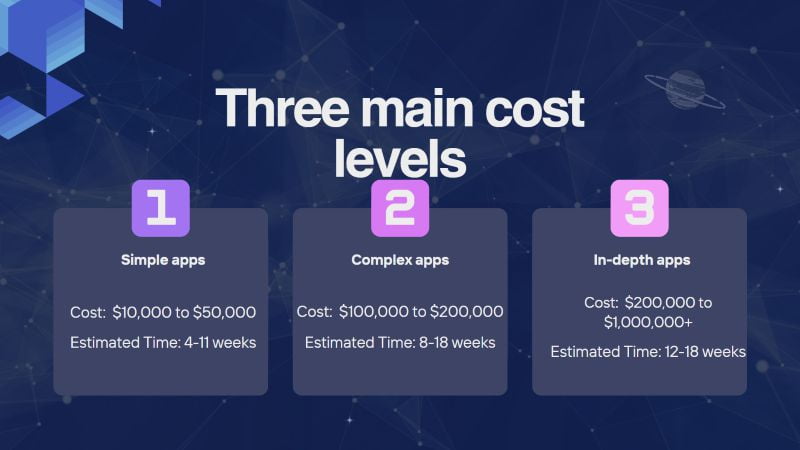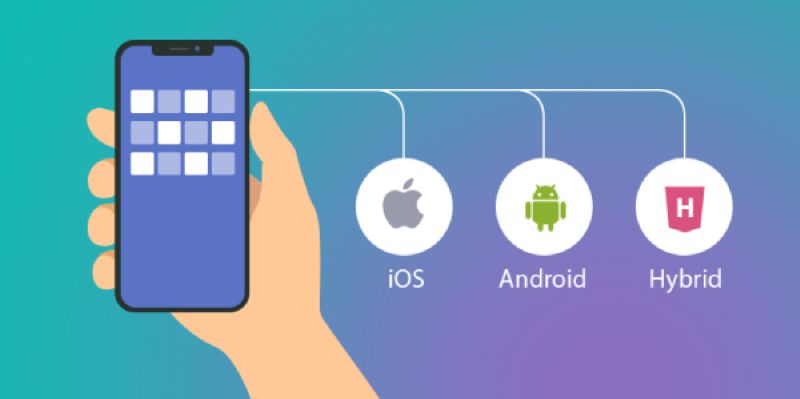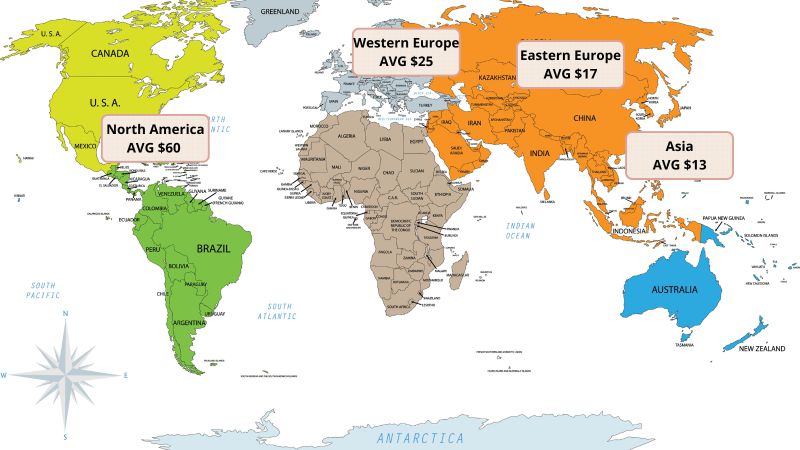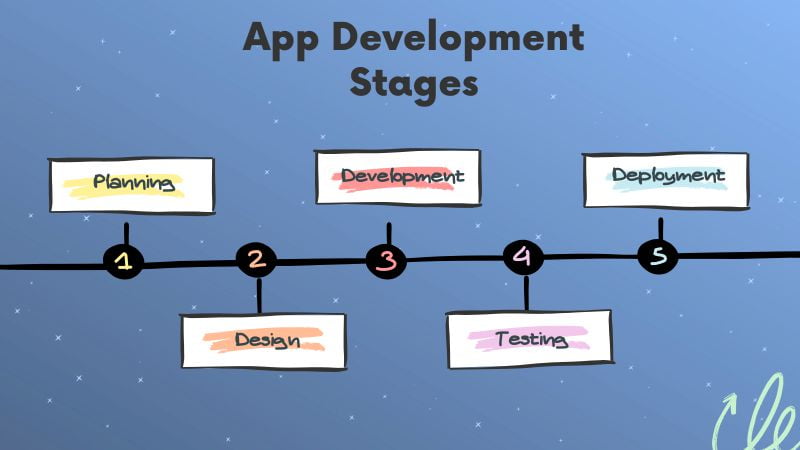Dreaming of creating a successful app that brings in big profits? That’s great, but before you step into the mobile world, be prepared for the upfront costs. App development costs are not fixed, they entirely depend on the scale and complexity of the brainchild about to be born. From $5,000 to over $1 million, the journey of bringing an app from the drawing board to the hands of users can be more expensive than you think. The more features and complexity, the higher the number increases exponentially.
Budgeting and planning ahead are essential. Equip yourself with knowledge about average costs, from development to App Store launch, to avoid surprises. What factors affect the cost? How to save money while still ensuring app quality? All will be revealed in this article, helping you embark on the app creation journey with solid preparation.
How much does it cost to create an app?
Mobile apps have become an indispensable part of our lives. From simple apps like weather alerts, wifi speed checks, and calendars to complex apps like social media, healthcare apps, e-commerce, and games, mobile apps can be used for a variety of purposes.

So, How much does it cost to create a mobile app? The amount depends on some things, but usually there are three main cost levels:
Simple apps
Basic apps provide straightforward features without many intricate functions. Light meters, calculators, and weather forecasts exemplify simple programs. Developing such an app usually costs $10,000 to $50,000 and takes approximately 4-11 weeks to finish.
Complex apps
Complex applications include numerous functions and need advanced technical expertise. The expense of creating an intricate application usually varies between $100,000 to $200,000 and generally requires 8-18 weeks to finish.
In-depth apps
Specialized apps address precise industries and need advanced technical abilities and proficiency. The cost of building a precise app commonly ranges from $200,000 to $1,000,000+ and generally requires around 12-18 weeks to complete.
How much does it cost to build an app by yourself?
Creating an app by yourself is possible if you have the technical know-how. While conventional app development involves a team, solo ventures are becoming more common. Working alone might extend the development timeline, typically taking 3 to 6 months for a complete app.
Costs vary based on complexity and the size of the envisioned project. Even with a one-person team, financial investment depends on factors like the app’s functionalities and your project’s scale. Fundamentally, solo application improvement expects specialized abilities, time pledge, and comprehension of the application’s perplexity, offering a more reasonable yet testing excursion.
Factors Affecting the Cost of App Development
App Type and Complexity
The type of app being made can have a significant impact on how much it costs to make. More complex apps, with specific requirements or with larger size and scope, are typically more expensive to develop.
When planning an app development project, it is important to consider the kind of app being developed as well as other aspects that may influence development costs. This will assist you in developing a realistic budget for your project.
The list of popular app types:
- Social: Connect with friends, share information, and interact with each other (e.g., Facebook, Instagram, Twitter)
- E-commerce: Buy and sell goods online (e.g., Amazon, Shopee, Lazada)
- Entertainment: Play games, watch movies, listen to music (e.g., YouTube, Netflix, TikTok)
- Productivity: Manage time, tasks, and projects (e.g., Trello, Evernote, Asana)
- Education: Online learning, exam preparation (e.g., Duolingo, Coursera, Udemy)
- Health and fitness: Track health, exercise (e.g., MyFitnessPal, Strava, Headspace)
- Travel: Book hotel rooms, flights, plan trips (e.g., Airbnb, Booking.com, Tripadvisor)
- Tools: Support specific tasks such as photo editing, note-taking, financial management (e.g., Canva, Adobe Photoshop, Evernote)
| App Type | Estimated Time to Develop | Estimated Cost |
| Social Media | 1300h | $50,000-$350,000 |
| E-commerce | 1,500h | $50,000-$250,000 |
| Entertainment | 1,600h | $80,000-$300,000 or more |
| Productivity | 1200h | $50,000-$150,000 |
| Education | 1300h | $50,000-$250,000 |
| Health and fitness | 1200h | $55,000-$300,000 |
| Travel | 1400h | $50,000-$300,000 |
| On-demand | 1200 and more | $50,000-$300,000 |
Platform

The choice of platform indeed influences software development costs
Choosing the right platform is important for mobile app creation and affects the total price. Here is an analysis of how the platform choice influences software development costs:
iOS Application:
- Developing a native iOS app involves integrating factors such as optimization for the Apple ecosystem and a specialized development process for iOS. Expenses can differ based on functions, intricacy, and striking visuals.
- Cost: $75,000 – $500,000
Android Application:
- Building a native Android app requires a focus on diverse devices and Android OS versions. The cost of app development can differ depending on how complex the features are and how well the app works with different versions of Android.
- Cost: $50,000 – $500,000
Hybrid Application:
- Developing a hybrid or cross-platform app reduces costs compared to parallel development for both iOS and Android. However, costs might be higher due to the use of intermediary technologies and the maintenance of compatibility on both platforms.
- Cost: $90,000 – $700,000
The choice between iOS, Android, and hybrid apps poses a significant decision regarding costs and performance. This significant choice should consider business aims, intended users, and the project needs to guarantee effectiveness and value.
Region

The cost to make an app depends on lots of things. One big thing is where you make it. Regions where living costs and pay are higher usually have higher software costs. On the other hand, places where living costs and pay are lower usually have lower app development costs.
When choosing a region to develop software, you need to consider the following factors:
- Budget: If your budget is limited, you may consider developing software in regions with lower costs.
- Quality requirements: If you require high quality and professionalism, think about making software in places where costs are higher. Those areas might have workers with more skills.
- Time and communication requirements: If you need to develop software in a short time or need to ensure effective communication with the development team, you may consider developing software in regions with a closer geographical location.
Comparison table of software development prices by region
| Region | Feature | Pros | Cons | Average Hourly Rates |
| North America and Western Europe | Highest hourly rate for development teams | High quality and professionalism, experienced team | High development costs | $25-$60 |
| Eastern Europe | Lower hourly rate than North America and Western Europe | Reasonable development costs, knowledgeable team | May experience difficulties in terms of time and communication | $17 |
| Asia | Lowest hourly rate for app development | Very reasonable development costs, diverse team | May sometimes encounter complexities in understanding the specific culture and requirements of the customer market | $13 |
Timeline and Project Deadline
Timeline and project deadlines are two important factors that can affect the cost of app development. When timeline and project deadlines are compressed, the cost of app development can increase due to the following factors:
- Increased labor costs: Developers may charge higher rates for projects with tight deadlines, as they need to work longer hours and focus more to meet the deadline.
- Reduced quality of testing and debugging: When development time is compressed, developers may not have enough time to perform thorough testing and debugging, leading to more bugs, requiring additional time and costs to fix.
- Reduced negotiating power: When time is a factor, customers may have less leverage to negotiate prices and features of the app, leading to higher costs.
Factors Affecting the Impact of Timeline and Project Deadlines on App Development Costs
The extent to which timeline and project deadlines affect the cost of app development depends on a number of factors, including:
- App complexity: More complex apps with more features and integrations will be more affected by compressed timeline and project deadlines.
- Development team size and structure: A larger development team with specialized skills may be able to meet more compressed project deadlines without significant cost increases.
- Development methodology: Agile development methodologies, which involve iterative cycles and flexibility, can help development teams meet more compressed project deadlines without significant cost increases.
Key Factors Driving Hidden Costs in App Development
Multi-platform Support
Cross-platform support is a major hidden cost factor that can impact the cost of app development. Developing an app that runs on multiple platforms, such as Android, iOS, and Windows, requires more time, effort, and resources than developing for a single platform.
Building apps for multiple devices like phones, tablets and computers has hidden costs. It takes more workers, tools, storage, testing, and maintenance. Cross-platform work makes projects harder, longer, and riskier too. Labor, development tools, storage, testing, and maintenance all cost more. Projects become complex, take more time, and have added risks.
It’s important for companies to think about who will use their app, what they can afford, and what they need the app to do before choosing if they will make one for different devices like phones and computers. They need to look at their customers, budget, and goals.
Third-party API or service integration
Third-party integration is a major factor that can impact the price of software development. Integrating with third-party services can add new features and capabilities to your app, but it can also increase development costs.
For example, an e-commerce app might integrate with third-party services like payment processing, shipping, or product reviews. These integrations can make the app more powerful and user-friendly, but they can also add to the time and expense of development. Businesses should carefully consider their needs and budget before deciding whether to integrate third-party services.
Marketing Costs
Making apps is just the start. You must tell others about your app to get people using it. Marketing helps more people find your app. It can also help people keep using your app more. That can mean making more money.
Marketing costs can be significant, so it’s important to plan and budget accordingly. Depending on your target market and marketing goals, you can expect to spend anywhere from $5,000 to $10,000 per month or more.
App Maintenance and Updates
While the excitement of launching a mobile app is often the main focus, many businesses underestimate the cost of ongoing app maintenance and updates. This important factor, often considered a hidden cost, can have a significant impact on your long-term budget if not adequately planned for.
Unlike development, which has a finite timeline and cost, maintenance is an ongoing process. Fixing bugs, patching security vulnerabilities, and updating features require a continuous investment of time and resources from developers.
Serious bugs or security vulnerabilities may need to be addressed immediately and can incur unplanned costs. Additionally, keeping up with the latest technology and user feedback is essential to retaining users and preventing churn.
So, always remember: app maintenance and updates are not optional afterthoughts. By acknowledging them as a hidden cost and implementing effective strategies, you can manage ongoing costs, ensure high-quality performance, and ultimately contribute to the long-term success of your mobile app.
App Development Stages and Costs

The mobile app development process can be broken down into five stages, each with its own purpose and cost. Here is a brief overview of each stage:
Stage 1: Planning
Defining the app and conducting research is the initial critical step. The purpose, audience, and key functions must be established. Additionally, researching competitors helps uncover what makes this app stand out. Typically, 10% of the overall budget covers planning and preparation.
Stage 2: Design
At this stage, the user interface and user experience for the app are designed. Wireframes and prototypes will showcase the different app features. The cost depends on project complexity, design type, and developer experience. For most projects, design typically costs around 15% of total development.
Stage 3: Development
This stage involves writing the code for the app based on the approved designs and features. The features will be debugged and tested to ensure the app runs smoothly. The cost for this stage depends on the number of features, target platforms (Android, iOS, etc.), and expertise of the development team. The estimated cost for this stage is 60% of the total app development cost.
Stage 4: Testing
At this stage, the app undergoes rigorous testing to detect and repair any glitches, mistakes, or crashes. The expense for this stage relies on elements like the features integrated, testing tools applied, and size of the testing crew. Commonly, the approximated outlay for testing is about 10% of the total cost to build the app.
Stage 5: Deployment
Once testing is complete, the app launches on app stores and websites. The cost at this stage relies on the distribution channel and rollout approach (for example, app store submission fees). Typically, launching accounts for around 5% of the overall app budget.
Note: These are just estimates, the actual cost for your app may vary depending on specific factors such as the complexity of the app, features, and location of the development team.
How does Nexle estimate the development cost of an application?
1. Market Research Phase:
Understanding your target audience and the current app landscape does not need to break the bank. Primary research consists of examining available apps, potential users, and latest trends – work that can largely be accomplished using free or low-cost online resources.
The goal of this initial step is to determine the viability of the application and lessen the chance of creating a product that customers do not want. Doing this investigation up front can prevent wasting resources on developing something that will not sell.
2. Initial App Version:
Beginning with a foundational app version can help decrease significant expenses. This lessens the time and assets important for coding, structure, and testing.
The expenses concentrate predominantly on the essential capabilities of the application and guaranteeing steady working.
At this stage, getting user input before developing intricate functions and expanding the program can help optimize the path ahead and lessen long-term expenses. Their feedback will provide perspective on refining what is made to fit needs better with less waste of effort over time.
3. Continuous Development:
How much continuous development costs relies on how often changes happen, how many new abilities are made, and how tricky the changes are.
Nexle prioritizes consistent updates to enhance the user experience, address security risks, and keep pace with shifting market needs. However, ongoing improvements may drive up development expenses long-term.
Conclusion
App development costs can differ greatly based on features, platform, complexity and developer location. Careful planning and research are crucial if considering app creation. This approach helps maximize returns on investment.
Whether you require guidance concerning application advancement evaluating, Nexle can help. We have both the experience and aptitude expected to assist you with creating an application that addresses your necessities and suits your financial plan.
To learn more, please contact us at +1 951 888 9080.
Table Of Content


